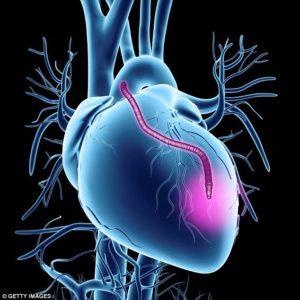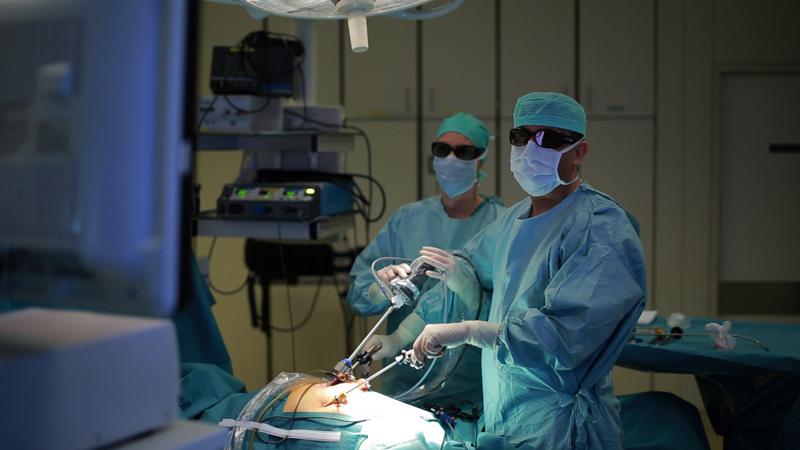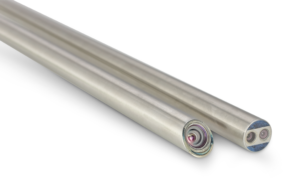Coronary artery disease is a condition that develops when cholesterol and calcium deposits begin to build up inside the arteries, causing them to become narrower and restrict blood flow to the heart. The resulting chest pain from the reduced blood flow is called an angina, and is often seen as a precursor to a heart attack if the artery becomes completely blocked. One of the more common procedures used to repair these blocked arteries involves placing small metal tubes called stents inside the artery to keep it open and prevent further blockage. These procedures can typically be done relatively easily using minimally invasive keyhole, or laparoscopic, surgeries. Unfortunately stents are not always capable of repairing the blockage and a more complex, and invasive, surgery needs to be performed.
If the block is too extreme, then doctors will take a blood vessel from behind the breastbone, or occasionally from a leg or an arm, and use it to bypass the blockage in the heart. The results are usually completely effective, however the surgery is quite invasive and requires the breastbone to be cut open in order to expose the heart. That kind of incision will often take up to six months to fully heal, and many times the patient already isn’t in the best of health, making the surgery quite risky. Doctors have tried using laparoscopic surgeries, however the 2D image that are sent back from the camera often makes it difficult to judge where incisions need to be made. Using a laparoscopic procedure turns the four-hour surgery into a six-hour surgery, and generally can’t be used for more difficult surgeries.
However with the rapid advancement of 3D camera technology, doctors at King’s College Hospital in London, UK have begun exploring using 3D imaging to perform more complex surgeries laparoscopically. Earlier in the year 62-year-old Bruce Fancourt from Kent was told that one of his arteries had become 96% blocked and the only way to repair it was with a bypass operation. But rather than cut open his chest, or risk a 2D laparoscopic procedure, a team of NHS hospital cardiothoracic surgeons led by Dr. Ranjit Deshpande used new 3D cameras in place of the old 2D system and successfully repaired the artery. The 3D system was not only less invasive and safer, but it dramatically reduced the amount of time that was required to perform the surgery down to two hours.
“3D technology means we still perform keyhole surgery, with all the same benefits for the patient, but in such a way that we can visualise the patient’s anatomy as if we were doing open heart surgery. This is a major step forward, and I am confident more patients like Mr Fancourt will benefit in the future,” said Dr. Deshpande.
The 3D technology works a lot like the 3D projection systems in movie theaters, and requires surgeons to wear a special pair of glasses in order to see the images properly. Along with the surgical tools used to perform the surgery, a tool with two cameras, each at right angles to each other, called a thoracoscope is inserted into a small incision in the patient’s chest. The images from the two cameras are transmitted to a screen in the operating room where they are superimposed on top of each other. The 3D glasses allow the surgeons to experience the inside of the patient’s anatomy in full three dimensions, as if they had actually opened the patient’s chest up. Using the thoracoscope, the surgical team can see the anatomy from all angles and perform the procedure faster and more accurately.
The process is called an Endoscopy Assisted Coronary Artery Bypass Surgery, and it is being used on patients who need one or two bypass grafts. However as the NHS surgeons become more experienced they expect to use it on triple or quadruple bypass grafts as well. The NHS also hopes to use the 3D technology during more complex heart surgeries like heart valve repairs and repairing congenital heart problems like holes in the heart. If the surgery is performed correctly, the grafts can stay in place for up to 20 years without any problems, and according to the Daily Mail, the entire procedure only costs the NHS £9,000 ($1320).
While the 3D thoracoscope technology had been used for other procedures at King’s College Hospital, it was only for relatively minor surgeries like gall bladder and prostate operations. The surgery on Mr. Fancourt was the first time that the technology was ever used in the UK for a heart bypass. Because the surgery was significantly faster and less invasive, Mr. Fancourt was out of the hospital in just four days, and had almost fully recovered within two weeks. Discuss this amazing technology further over in the 3D Imaging for Heart Surgery forum over at 3DPB.com.
Subscribe to Our Email Newsletter
Stay up-to-date on all the latest news from the 3D printing industry and receive information and offers from third party vendors.
You May Also Like
3D Printing News Briefs, April 13, 2024: Robotics, Orthotics, & Hypersonics
In 3D Printing News Briefs today, we’re focusing first on robotics, as Carnegie Mellon University’s new Robotics Innovation Center will house several community outreach programs, and Ugogo3D is now working...
Rail Giant Alstom Saves $15M with 3D Printing Automation Software 3D Spark
3D Spark has entered into a three-year deal with the rail giant Alstom. Alstom, a transport behemoth with annual revenues of $16 billion, specializes in the manufacture of trains, trams,...
Meltio Expands Global Reach with New Partnerships in the Americas and Europe
Spanish 3D printing manufacturer Meltio has expanded its sales network across the globe. With the addition of three new partners in the United States, Brazil, Argentina, and Italy, Meltio aims...
3D Printing Webinar and Event Roundup: April 7, 2024
Webinars and events in the 3D printing industry are picking back up this week! Sea-Air-Space is coming to Maryland, and SAE International is sponsoring a 3D Systems webinar about 3D...



































